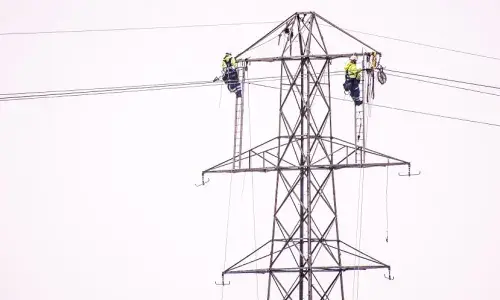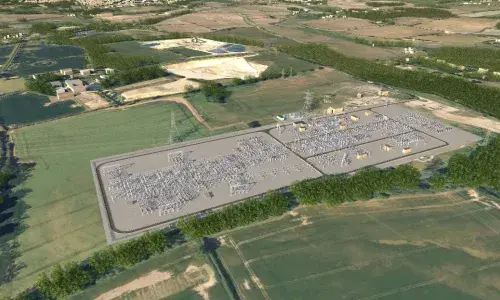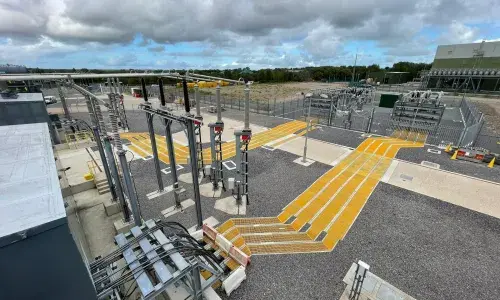
User connection boundaries
Understanding where National Grid Electricity Transmission (NGET) ownership responsibilities end and user responsibilities begin, is key when planning a connection to the electricity network.
User connection boundaries
Understanding where National Grid Electricity Transmission (NGET) ownership responsibilities end and user responsibilities begin, is key when planning a connection to the electricity network.
When you apply for a connection, NGET assesses:
- Existing substation capacity
- Planned or ongoing enabling works
- Potential need for new assets
Once accepted, your connection site is defined, and Points of Connection (PoCs) are assigned - these are the exact physical points where your assets connect to the grid (e.g. bay or cable sealing end). The precise boundary between user-owned assets and NGET assets depends on asset type and connection type.
Boundaries by asset type
Air Insulated Substation (AIS)
AIS assets generally specify the user boundary as:
- the busbar clamp,
- cable sealing end, or
- a disconnector that connects the user from their own equipment into the substation busbars.
Any equipment beyond that and into the substation is the responsibility of NGET. This configuration can differ in terms of the type of connection, for example, a pantograph disconnector is often used with generation connections, but in AIS, there is generally a clear point of visual demarcation at which responsibility is transferred.
Gas Insulated Substation (GIS)
GIS boundaries can be marked by the following:
- First busbar gas zone after the user’s busbar selectors, or
- the outgoing circuit gas zone
Boundaries by connection type
Generation and Interconnectors
Generation connections cover a broad spectrum, from traditional centralised plants like gas generators to modern technologies such as wind, solar, and battery storage.
Interconnectors, which link electricity systems across borders, also fall under this category and typically involve more substantial infrastructure.
Despite the variety, user boundaries for both types are generally consistent. The boundary is usually the first point of connection to the AIS substation busbars (this may be via a busbar clamp to main or reserve bars or a moving disconnector) or in the case of GIS substations, the first busbar gas zone on NGET’s busbars.
Demand connections
Demand connections are evolving rapidly, driven by growth in sectors like data centres and large industrial sites. These developments often require increased capacity across the network.
User boundaries for demand assets vary depending on the connection setup:
- Sole-use connections: NGET typically constructs a dedicated asset, cabled directly to the user. The boundary is marked by the disconnector or isolator where the low-voltage cable enters the user’s AIS site, or in the case of GIS substations, the first busbar gas zone on the user’s busbars.
- Shared substations: The user owns assets up to the connection clamp on the NGET AIS substation busbar, or in the case of GIS substations, the first busbar gas zone on NGET’s busbars.
Tertiary connections
Tertiary connections use a transformer’s third winding to support low-capacity connections, typically up to 57MW, designed for a single user.
The user boundary is located on the load side of the transformer, not the main busbar side. It’s typically marked by the isolator or disconnector that feeds into the user’s connection.
Grid Park connections
Grid Parks use a 400/33kV transformer to connect up to three users up to 150MW in aggregate.
The user boundary is on the AIS 33kV substation busbars (this may be via a busbar clamp to the main or reserve bars or a moving disconnector) or in the case of GIS substations, the outgoing circuit gas zone of the GIS bay connecting the given user.
Read more on the commonly offered types of user connections.
Distribution Network Operators (DNOs)
DNO connections reflect the integration between the transmission and distribution networks. They are responsible for the distribution of electricity from either the transmission system or embedded generators to homes and businesses.
User boundaries for DNOs depend on the connection setup:
- If connecting to a DNO-owned substation, NGET owns the assets up to the busbar clamp at the DNO AIS substation, or in the case of GIS substations, the first busbar gas zone on the DNO’s busbars.
- If connecting to a shared NGET substation, the DNO owns the assets up to the busbar clamp within the NGET’s AIS substation, or in the case of GIS substations, the first busbar gas zone on NGET’s busbars.
This ensures clear ownership and maintenance responsibilities across both networks.
Why doesn’t NGET own all connection assets?
As a transmission owner, NGET is committed to operating an efficient and cost-effective network. Any unnecessary costs incurred could reflect onto the end consumer.
To manage this:
- Standard connection works are covered under Ofgem’s general allowances.
- If a user requests higher-specification assets or additional assets to be owned by NGET, these are treated as one-off works, with costs passed directly to the user.
Even in these cases:
- NGET assumes ownership and maintenance of the asset after commissioning.
- Each request is carefully assessed to avoid unnecessary cost and complexity.
Wherever possible, NGET prioritises solutions within standard connection works before considering user requested one-off works.
Where broader strategic and operational requirements exist, NGET may require, and will offer, an alternate boundary of ownership that enables greater contiguous ownership of busbars and/or protective devices. The additional NGET-driven assets will not be subject to one-off works. The exact proposed ownership boundary will be stated in NGET’s offers of connection.


